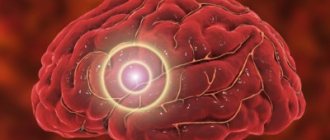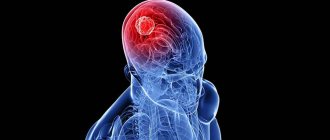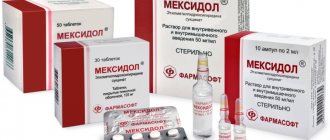What is a stroke
An acute sudden disruption of blood circulation in the brain, leading to damage to nerve cells, is called a stroke. The pathology is characterized by the formation of local or cerebral symptoms of a neurological nature, which last more than a day or lead to death due to cerebrovascular abnormalities. The location of the lesion is determined using MRI (magnetic resonance imaging).
There is a so-called “therapeutic window”, which is 3-6 hours after the impact - during this time, irreversible damage and cell death can be prevented with the help of therapeutic manipulations. A stroke can be hemorrhagic or ischemic in nature. In the first case, hemorrhage occurs in the brain or its membranes, in the second - blockage or narrowing of the blood vessels of the brain. In addition, there is a spinal stroke, characterized by damage to the spinal cord.
The ischemic type affects more often older people (statistically more likely - men), and is characterized by a gradual increase in symptoms. Due to vascular spasm, blood supply to the brain is stopped, which leads to oxygen starvation and cell death. There is an opinion that ischemic stroke can be triggered by factors such as stress, increased physical activity or alcohol consumption.
The hemorrhagic type is characterized by hemorrhage in the brain, while the death of nerve cells occurs due to compression of them by the hematoma. The main reason is thinning of the vascular walls due to cerebral pathology. In this case, the symptoms develop much faster and are accompanied by serious neurological abnormalities of varying severity.
In 5% of cases of the disease, it is not possible to determine the exact mechanism of brain damage. Treatment after a stroke consists of restoring nerve cells (neurons), relieving the effects of primary factors, and preventing a second stroke. Knowing the main signs of pathology can save someone’s life, since the time required to provide the necessary assistance for a stroke is 3–6 hours.
Is there a high risk of surgery performed for hemorrhagic stroke?
Hemorrhagic stroke is a very serious type of cerebrovascular accident in which there is a rupture of a vessel and associated bleeding.
The formation of a hematoma in this regard can lead to severe impairment of brain function and symptoms of severe neurological deficit.
The consequences of hemorrhage localized in the brain stem can be even more serious - from disability to death.
stroke of hemorrhagic type
This is due to a sharp inhibition of the activity of vital centers located in the trunk. Hemorrhagic stroke is always characterized by a severe course and severe symptoms. It is not always possible to help the patient with conservative measures, therefore, with continued bleeding and an increase in the size of the hematoma, a decision is often made to perform surgery.
Surgical treatment - a chance to survive or serious consequences
Fear of surgery among patients diagnosed with hemorrhagic stroke is largely due to low awareness of the procedure for the intervention and its effectiveness.
Operations are carried out only in specialized vascular centers, the level of equipment of which allows them to accurately diagnose hemorrhagic stroke, carry out interventions of varying degrees of complexity and deal with possible complications.
Hemorrhagic stroke is one of the few, although not absolute, indications for brain surgery.
This is due to the complexity of the operation itself and its consequences, the occurrence or severity of which is almost impossible to predict.
If a hemorrhagic stroke is caused by a rupture of a large artery, and it is not possible to stop the growth of the hematoma conservatively, surgical intervention becomes the only chance to save the patient’s life.
Doctors will never talk about brain surgery without good reason. It is worth knowing that the growth of hematoma and disruption of vital centers lead to death much more often than the operation itself.
Possible consequences of the operation
After successful brain surgery for hemorrhagic stroke, some complications may develop, the occurrence of which depends not only on the neurosurgeons, but also on the general condition of the patient. The main consequences of surgery performed for hemorrhagic stroke include the following:
- intracranial bleeding;
- infection;
- injury to surrounding tissues;
- cerebral edema.
It is impossible to determine in advance the risks of complications developing after surgery; their occurrence depends on the extent of the hemorrhagic stroke and a number of other factors.
These include the patient’s age, the presence of concomitant pathologies and the severity of central nervous system disorders that occurred before the operation.
If the course of the postoperative period is unfavorable, epilepsy, speech disorders, paralysis and paresis may develop.
Mesh for cranioplasty
If craniotomy was performed, a defect in the skull bones may be noted after the operation. If cranioplasty was not performed after trepanation, there is a high probability of developing trephine syndrome - generalized headache, weather dependence, pain in the area of the defect. Unpleasant sensations intensify with physical activity, coughing, and tilting the head.
Long-term consequences of surgical interventions
The consequences of an operation to eliminate negative phenomena caused by a hemorrhagic stroke can be not only immediate, occurring immediately after the operation, but also long-term.
To prevent them, maintenance therapy is prescribed; anticonvulsants and hormonal drugs can be used.
Taking them helps to cope with disturbances in the functioning of the central nervous system, but does not cancel the course of rehabilitation measures that are mandatory during the recovery period.
Among the long-term consequences of hemorrhagic stroke and surgical intervention, patients often note the following:
- severe memory impairment;
- periods of short-term clouding of consciousness;
- fatigue and physical weakness;
- mental changes, expressed in excessive aggressiveness or depression;
- disorders of the digestive system, leading to rapid weight loss.
One of the consequences of hemorrhagic stroke is memory loss
It is worth noting that such consequences are not necessarily associated specifically with the operation; a hemorrhagic stroke, even after conservative therapy, often “leaves” behind significant disturbances in the functioning of many body systems. In itself, surgery performed on the brain causes death quite rarely - such cases are recorded in no more than 2%.
Indications for surgery
Stroke is a pathology that requires immediate medical attention within several hours to avoid the development of irreversible processes. There are different methods to combat bleeding, but often the most effective is surgery after a cerebral stroke, which allows you to completely remove the source of hemorrhage. Indications for surgical intervention:
- Damage (swelling or compression) of the medulla oblongata with the formation of a progressive neurological defect - the so-called cerebellar stroke (with a focus of more than 3 cm).
- Hematoma on the cerebral cortex, reaching a depth of no more than 1 cm with a volume of released blood of no more than 30 ml.
- Vascular abnormalities of various natures (for example, malforation or aneurysm), accompanied by bleeding. Angiography is required to confirm the diagnosis.
- Comatose state lasting more than 6 hours. In this case, decompression by removing part of the skull is effective.
- Abscesses and swelling of the brain, trauma to the skull, and abnormalities in the development of the skull can cause a stroke.
Risks and possible consequences
It must be remembered that this disease carries a mortal danger. Therefore, whatever the risks, surgical intervention is simply necessary .
In most cases, thanks to timely surgery, the lives of more than 85% of patients were saved.
Frequent complications include cerebral edema. This occurs due to serious interference in the structure of the skull.
Also, high blood pressure and hemorrhage are considered frequent postoperative complications . The latter is the most life-threatening.
A stroke is a dangerous condition where minutes count. Timely professional assistance is the key to successful treatment. Read our materials about which doctor diagnoses the disease, how to care for the patient and what needs to be done at home, whether massage is needed after an attack, as well as what are the most effective drugs, folk remedies, and when and how to collect pine and spruce cones to treat the disease .
What kind of surgery is done for a stroke?
Any surgical intervention on the open brain is always a high risk and often ends in the development of serious complications, in some cases – the death of the patient. Surgery is performed only after an accurate diagnosis has been established and the ischemic or hemorrhagic type has been differentiated from other neurological pathologies (for example, cerebral aneurysms).
In recent years, several little-studied techniques for removing hematomas have emerged, requiring special equipment and trained medical personnel. Such operations include the stereotactic method, in which a small puncture is made in the skull, and the endoscopic method, which involves making a small hole. It should be remembered that all brain surgeries involve great risks.
Articles on the topic
- Coma after a stroke in a person
- Brain stem stroke - first signs and manifestations, drug therapy, surgery
- Cerebral edema during stroke - types, first manifestations, treatment methods, consequences and prognosis
For ischemic strokes
In most cases, ischemic stroke occurs against the background of hypertension, cerebral atherosclerosis, and heart defects. The pathology is characterized by impaired cerebral circulation, which leads to insufficient oxygen supply to the brain tissue and, as a consequence, destruction of nerve cells. Blockage of the arteries occurs due to broken pieces of atherosclerotic plaques and blood clots.
Therapy for ischemic stroke is aimed at restoring blood circulation in the cerebral vessels. For this purpose, antiplatelet agents, thrombolytics, and anticoagulants are used. In cases where conservative treatment is ineffective, surgery is performed:
- Carotid endarterectomy involves removing the inner wall of the carotid artery, which is affected by atherosclerotic plaque. It is performed under local anesthesia, implies a short rehabilitation period and causes fewer complications, since general anesthesia after a stroke can provoke a deterioration in the general condition.
- Carotid stenting is prescribed to patients who have undergone endarterectomy in the past or to those patients for whom it is contraindicated. It is carried out when the diameter of the lumen of the carotid artery narrows to 60%.
- Carotid artery stenting and blood clot removal are performed without incisions. The operation is performed using the endovascular method, during which a stent is inserted into the narrowed area of the artery, which helps ensure good blood flow.
- Selective thrombolysis is the administration of special drugs that dissolve blood clots.
Types of surgical intervention for hemorrhagic stroke
When stroke (acute cerebrovascular accident) of the hemorrhagic type occurs, several types of surgical operations are performed, but the effectiveness of each directly depends on the size and location of the hematoma. In addition, some of the newer methods have not been sufficiently researched. Several effective types of surgery:
- Craniotomy using the classical method involves making a hole in the skull and installing drainage. Used for acute cerebral edema, reduces mortality from stroke by 30%. The disadvantage of this method is that it is highly traumatic, since craniotomy during a stroke is always associated with risk.
- Insertion of a catheter into the hematoma cavity (sterotactic method) to remove the contents through aspiration. It is carried out in case of deep bleeding, sometimes with the addition of thrombolytics. The disadvantage is the inability to completely stop the bleeding.
- Removing part of the skull bone and covering the area with a skin flap is used when there is a threat of coma. If the patient's condition improves, repeat surgery is necessary.
- Aneurysm clipping involves placing a special clip on the neck of the aneurysm, which remains inside the skull and prevents recurrence of the disease.
Types of trepanation
Craniotomy is a complex operation. It is carried out in vascular centers with modern equipment. The operations are performed by highly qualified surgeons.
Trephination involves creating holes in the skull in order to gain access to the brain and further work with it. The procedure is performed both planned and as an emergency when the pressure on the brain is dangerously high or other methods are ineffective.
There are 2 types of trepanation:
- Osteoplastic trepanation. The purpose of the operation is to open the skull and remove tumors, hematomas, cysts, and eliminate the source of hemorrhage. The hole is made so that the path to the affected area is as short as possible so that the vessels are not affected. Upon completion of the manipulations, the integrity of all tissues affected during the operation (including bone) is completely restored. No re-operation is required.
- Resection (decompression) trepanation. The goal is to reduce intracranial pressure. This technique is used in emergency cases, when brain swelling increases, in the presence of tumors that cannot be removed. A hole is made in the area of the temporal bone so that the brain is not affected and the scar can be easily hidden in the future. The removed bone fragment is not restored. It can be replaced with synthetic inserts.
The first option is more gentle and the recovery process is easier.
Contraindications to surgery
Brain surgery is always a risk to the patient’s life, so the issue should be approached responsibly. If timely, high-quality medical care is provided and in the absence of destructive changes, death is possible in 25–35% of cases. The following contraindications for surgical intervention exist:
- arterial hypertension;
- heart failure;
- short interval between stroke and heart attack (less than six months);
- concomitant pathologies of the brain of a regression nature;
- the patient’s age exceeds 70 years (not always a reason for refusal);
- somatic diseases (diabetes mellitus, poor blood clotting, liver and kidney failure);
- malignant brain tumors;
- neurological deficit;
- unstable angina;
- mental illness;
- acute inflammation with the formation of pus;
- coma.
Contraindications
Surgical methods for treating stroke are used only if there are no contraindications. If they are present, only conservative therapy is allowed, regardless of the patient’s condition. Operation is prohibited in the following cases:
- Age over 75 years is a relative contraindication. At the discretion of the doctor, surgical intervention can be performed if the overall performance of the systems and organs is good.
- Coma.
- Extensive hemorrhagic stroke.
- Heart attack suffered less than 6 months ago.
- Progressive brain diseases such as Alzheimer's.
- The presence of severe chronic diseases - oncology, problems with blood clotting, disturbances in the functioning of the heart and lungs, kidney and liver failure, diabetes mellitus.
Ignoring contraindications is not allowed, since if they are present in the event of an intervention, there is a high risk that the patient will die at the time of the intervention or immediately after it.
In many cases, surgery is the only way to save the patient’s life. It will not be used unless absolutely necessary. Ischemic stroke is often treated conservatively. Patients' fears of intervention are in most cases unjustified, since stroke is an extremely dangerous disease that leads to serious consequences much more often than surgery.
Postoperative period
Therapy during the recovery period is to prevent the progression of cerebral edema and prevent recurrent hemorrhage. In addition, possible serious complications may include:
- paralysis;
- changes in speech and motor activity;
- loss of vision;
- disorders of the central and autonomic nervous system (memory impairment, slurred speech, etc.).
A significant factor is the timing of the operation - the patient’s condition in the postoperative period remains unstable for a long time if the surgical intervention was performed late. There may be a temporary or permanent decrease in the patient's intellectual abilities, speech impairment and clouding of consciousness.
The main complication after stroke surgery is swelling of the brain tissue, which can last up to two weeks. This condition is life-threatening; to eliminate it, the patient is administered osmotic and diuretics (for example, Mannitol, Lasix), barbiturates (Sodium Thiopental), and hyperventilation is performed in sessions of short duration.
In addition, it is necessary to constantly monitor the patient’s blood pressure, since hypertension can provoke new or worsen old bleeding. The level of systolic pressure should not exceed 130 mmHg, otherwise drugs with a short duration of action are prescribed for better correction of hemodynamics.
After the operation, the patient may complain of general malaise, gastrointestinal upset, and nausea. Temporary clouding of mind and dizziness are possible. The postoperative period is characterized by a general loss of strength and sudden weight loss. In addition, patients who have suffered a stroke often suffer from stress and nervous exhaustion, so during this period they especially urgently need care and attention from loved ones.
Complications
Complications after surgery occur when the patient’s condition is serious, when the body is not able to recover. The main negative consequences that can occur even after a successful operation are:
- Bleeding. It may appear when the vascular walls are highly fragile. In this case, within 2 days after the intervention, a violation of their integrity may occur and bleeding may develop.
- Infection. Such a complication is often the fault of medical personnel who, to one degree or another, violated sanitation rules during the operation.
- Damage to the brain tissue surrounding the affected area. In the case of intervention in a hard-to-reach area of the brain, when the patient’s life depends on it, doctors may disrupt the condition of the surrounding tissues, due to which certain functions of the body may suffer. Most often observed when a hemorrhagic stroke occurs in the cerebellum.
- Brain swelling.
- Coma.
It is impossible to determine the risk of complications before surgery. The doctor warns the patient that there may be complications. However, he will not be able to say for sure whether they will appear. According to statistics, during surgical treatment of stroke the risk of death is 2%. The likelihood of an unfavorable outcome increases if a particularly severe hemorrhagic stroke occurs.
Some patients may experience speech and motor coordination disorders and epilepsy for the rest of their lives after surgery.
When the operation was performed with a serious violation of the integrity of the skull bones (craniotomy), without further plastic surgery there may be visible defects. The appearance of trephine syndrome cannot be ruled out, in which weather dependence, headaches and discomfort in the surgical area occur with significant stress, coughing and bending forward.
Consequences and prognosis for the patient
A serious danger is posed by possible bleeding, which, in the presence of concomitant pathologies, can cause decompensation. Difficulties associated with the treatment of stroke lie in the initial severe course of the disease and the insignificant effect of drug therapy on the outcome. Surgery for cerebral stroke using the classical method can only slightly improve the patient’s prognosis.
Death usually occurs in the case of hemorrhagic stroke due to repeated bleeding or progressive cerebral edema. Disability is recorded in every second patient due to neurological disorders. The final outcome of stroke treatment is significantly influenced by the size of the hematoma. Possible infectious complications, blood clots and blood clots also affect the positive or negative outcome of stroke surgery.
Long-term complications
After a stroke, the treatment of which required surgery, long-term negative consequences may also occur. It is not always possible to say for sure whether they are related to the primary disorder (stroke) or surgery. If the patient strictly followed all medical recommendations during the rehabilitation period, then the risk of long-term complications is significantly reduced.
Long-term complications of stroke treated surgically are:
- memory impairment;
- short-term disturbance of consciousness;
- increased fatigue;
- mental disorders that cause depression or attacks of aggression;
- a change in the functioning of the digestive system, due to which the patient loses weight in a short time to the point of exhaustion.
In most cases, long-term consequences occur when the patient’s condition is initially severe.
Postoperative stroke
Strokes are considered intraoperative if, after waking up from anesthesia, the patient develops new neurological symptoms, and postoperative if these symptoms appear some time after the operation.
According to previous studies, postoperative strokes generally predominate, and more often they occur in patients who have suffered a cerebral infarction and who simultaneously have partial or complete impairment of cerebral hemodynamics.
High-risk patients are more vulnerable to minimal changes in cerebral perfusion or embolism. That is why technical errors should be minimal or not allowed at all.
After the Leicester Clinic began completing each CEA with control angioscopy, the incidence of postoperative stroke decreased from 4% to 0.2% (per 1200 CEA performed).
Postoperative strokes are often caused by thrombosis of the internal carotid artery (especially in the first 6 postoperative hours) and bleeding.
It has been proven that in most cases, thromboembolic complications are the result of technical errors, so it is necessary to make every effort to ensure that they are identified during surgery. In 1-2% of cases, CEA is complicated by intracranial bleeding or hyperperfusion syndrome.
These complications more often occur in patients with severe bilateral damage to the carotid arteries, reduced cerebral vascular reserve, impaired autoregulation mechanisms and insufficient development of collaterals.
It is important that emergency department staff understand the importance of early treatment of seizures, which usually occur in the first 5-7 days after CEA. These patients are at very high risk of intracranial hemorrhage and the mainstay of treatment is seizure control as well as aggressive blood pressure control.
Treatment of postoperative stroke
The management of patients with perioperative neurological events is determined by:
- 1) time of their appearance (during or after surgery);
- 2) the cause of postoperative stroke (thrombosis, embolism, bleeding);
- 3) the severity of the neurological deficit.
In general, the more severe the neurologic deficit, the more likely occlusion of the internal carotid artery or middle cerebral artery is.
In the absence of the ability to perform transcranial Doppler sonography and duplex mapping, it should be assumed that any neurological deficit that occurs after the patient awakens or in the first 24 hours after surgery is due to thromboembolism.
In this situation, it is necessary to inspect the wound to exclude any technical errors and ongoing embolization. Although wound revision does not improve the condition of patients with local embolism or hemodynamic insult, it is currently indicated in all patients with new neurological deficits.
If it is possible to perform transcranial Doppler sonography and duplex mapping, then the decision is easier to make. First of all, it is necessary to exclude thrombosis of the internal carotid artery, because in this case, an immediate revision of the reconstruction is required.
If blood flow during a stroke can be restored within the first hour after the occurrence of thrombosis, a good recovery of neurological function can be expected.
Pathognomonic Doppler signs of internal carotid artery occlusion include the appearance of reverse flow through the ipsilateral (located on the same side) posterior cerebral artery and, most importantly, the flow velocity at the level of the middle cerebral artery is similar to that during cross-clamping of the carotid arteries.
However, it is absolutely clear that one should strive to prevent thrombosis. Data obtained from clinics located on three continents indicate that 1-2 hours before thrombosis, embolization of the cerebral arteries in patients increases, which can be detected by transcranial Doppler sonography, and in 50-60% of cases, persistent embolization ends in thrombotic stroke.
At the Royal Leicester Hospital, we treat 5% of patients with a high embolic rate (>25 in 10 minutes) with dextran 40. Since this treatment was introduced in October 1995, none of the 900 CEAs have been complicated by stroke due to carotid thrombosis. Neurologists consider this a significant achievement, because... Previously, thrombotic postoperative strokes occurred in 2-3% of patients in the first 6 postoperative hours.
The article was prepared and edited by: surgeon I.B. Pigovich.
Source: https://surgeryzone.net/nevrologia/posleoperacionnyj-insult.html
What causes a cerebral stroke, how to avoid it, prevention and treatment
Good day, dear friends. Today is a very serious topic, let's talk about cerebral stroke. Stroke is an acute cerebrovascular accident (CVA).
ACVA is a dangerous disease, but many still undeservedly ignore this dangerous disease, despite the enormous scale of its spread. Take some time to read this article and benefit your health by learning about the causes of this disease and how to prevent it. What causes a stroke?
What causes a stroke?
Typically, the cause of stroke is the formation of a blood clot in a cerebral artery. Quick treatment is the use of drugs to dissolve blood clots. Other treatments include medications that reduce the risk of subsequent strokes.
Rehabilitation measures play an important role in the treatment of this disease. The risks of developing disability after stroke depend on the location of the blood clot, the promptness of subsequent treatment, and the degree of brain damage. If you suspect the presence of stroke, you must immediately call an ambulance.
Causes
With stroke, there is a sudden interruption of the blood supply to a certain part of the brain. Brain cells require a constant supply of oxygen from the blood, so soon after the blood supply is blocked, brain cells begin to die. Blood enters the brain through two internal carotid arteries and two vertebral arteries.
If a blood clot forms in the carotid artery, extensive brain damage can occur, even leading to death. If a blood clot forms in one of the small branches of this artery, then the symptoms may be minimal. There are two main types of stroke - ischemic type and hemorrhagic.
Ischemic type
The term ischemic refers to a condition with reduced blood and oxygen flow to a specific part of the body. This is usually caused by a blood clot forming in an artery that blocks blood flow. Ischemic stroke occurs in approximately 70% of cases.
Hemorrhagic type
This type of stroke develops when a weakened artery ruptures. Intracerebral hemorrhage causes blood to leak into the brain tissue. This leads to nerve cells being deprived of oxygen and dying.
This phenomenon occurs in 10% of cases. When bleeding occurs in the space between the brain and the arachnoid membrane, subarachnoid hemorrhage develops, which occurs in approximately 5% of cases. Normally, this space is filled with cerebrospinal fluid.
At what age can a stroke occur?
In developed countries, stroke is one of the main causes of death in older people, as well as the development of disability in them. Most cases have been reported in people over 65 years of age. In developed countries, every year there is one stroke per 100 people over 75 years of age.
However, this disease can develop at any age, even in infants. Although stroke at a young age is much less common. Many elderly people live with the consequences of a stroke. In approximately half of the cases, people after an acute stroke require the help of others.
First signs and symptoms
The functioning of different parts of the body is controlled by different parts of the brain. Therefore, the symptoms of stroke vary depending on which part of the brain is affected. Symptoms usually develop quite suddenly and usually include at least one of these:
- Weakness in an arm and/or leg. The degree of manifestation can vary from complete paralysis of one side of the body to slight clumsiness in one of the arms.
- Weakness or discoloration of one side of the face.
- Problems with balance, coordination, vision, speech, communication and swallowing.
- Dizziness, unsteadiness.
- Numbness of body parts.
- Headache.
- Confusion.
- Loss of consciousness in especially severe cases.
How does a microstroke manifest?
The symptoms of a microstroke resemble those of stroke, but they do not last more than 24 hours. This is caused by a temporary lack of blood flow to a certain part of the brain. In most cases, a ministroke is caused by a tiny blood clot in a small artery.
For a few minutes, the blood flow is blocked and there is a lack of blood supply in a small area. After this, the clot disintegrates or the blood supply is redistributed to adjacent blood vessels.
Despite the fact that the symptoms of a mini-stroke pass fairly quickly, immediate medical attention is required. This is due to the fact that the risk of developing a regular stroke is increased.
Coma after a stroke: how many days lasts, chances of survival
Coma is a borderline state between life and death. The result of inhibition of nerve impulses in the cerebral cortex, subcortex, and underlying sections.
Clinically manifested by lethargy or loss of consciousness, decreased/lack of response to external stimuli, and disappearance of reflexes.
Let's look at why coma develops after a stroke, what its duration is, the chances of survival and a full recovery.
Mechanism of coma development
Damage to neurons is accompanied by changes in the metabolism of nervous tissue. Intracellular fluid exits into the intercellular space.
As it accumulates, it compresses the capillaries, causing the nutrition of nerve cells to deteriorate even more and their work to be disrupted. A comatose state can develop very quickly (several seconds or minutes) or gradually (up to several hours, less often days).
Most often, coma occurs after a massive or brainstem stroke caused by hemorrhage, less often by blockage of the cerebral arteries.
Severity
There are 5 degrees of coma after a stroke of varying severity:
- Precoma – moderate confusion, stupor. The victim looks drowsy, reacts inhibited to external stimuli, or, on the contrary, is overly active.
- 1st degree – severe deafness. The patient reacts very slowly to strong external stimuli, including pain. Can perform simple actions (rolling around in bed, drinking), respond with a meaningless set of words/individual sounds, muscle tone is weak.
- 2nd degree – loss of consciousness (stupor), basic reflexes are preserved (reaction of the pupils to light, closing of the eye when touching the cornea). When approaching the patient, there is no reaction, his rare movements are chaotic. Pain reflexes are suppressed. The nature of breathing changes: it becomes intermittent, shallow, and irregular. Possible involuntary urination and bowel movements. Trembling of individual muscles and twisting of limbs are observed.
- 3rd degree – loss of consciousness, absence of pain response, some basic reflexes. Involuntary urination, defecation. Muscle tone is reduced. The pulse is palpable poorly, breathing is irregular and weak, body temperature is reduced.
- 4th degree (extraordinary) – absence of any reflexes. Agonal breathing, palpitations, ends in death.
Why is an artificial coma needed?
An artificial state is called a coma, which is achieved by administering narcotic substances (most often barbiturates) or cooling the patient’s body to a temperature of 33 degrees.
They cause cerebral vasoconstriction, slowing cerebral blood flow, and reducing blood volume.
Medically induced coma during stroke is necessary for some patients to eliminate cerebral edema - the most severe complication, causing more than 50% of deaths.
This technique is rarely used due to the large number of complications and unexpected results.
Duration of coma
The duration of a coma can be very different: from several hours to several days or weeks. Some patients die without regaining consciousness. Rarely does a patient remain in a coma for several months, a year, or more. But the chances of recovery after such a long coma are extremely low.
A quick exit is more likely when:
- moderate area of necrosis;
- ischemic nature of stroke;
- partial preservation of reflexes;
- young age of the patient.
Prognosis, recovery after coma
Post-stroke coma is considered the most severe type of coma (1):
- only 3% of patients manage to recover and fully recover;
- 74% of comas after a stroke end in death;
- 7% of patients manage to regain consciousness, but they lose all higher functions (the ability to think, talk, perform conscious actions, carry out commands);
- 12% of patients remain deeply disabled;
- 4% of people recover, maintaining moderate impairment.
Factors influencing the forecast:
- Localization of the focus of necrosis. If a stroke affects the medulla oblongata, where the centers for controlling breathing and heartbeat are located, death occurs very quickly.
- Duration of coma: the longer it lasts, the less hope for a full recovery, the higher the risk of death.
- Depth of coma. In medicine, the Glasgow scale is used to assess it. During the examination, the doctor tests a person’s ability to open their eyes when exposed to various stimuli, speech, and motor reactions. For each attribute a certain point is awarded (table). The lower the score, the less favorable the outcome for the patient.
ReactionBall
| Eye opening when pressed | |
| There is | 2 |
| No | 1 |
| In response to the patient's question | |
| answers inappropriately | 3 |
| makes strange sounds | 2 |
| does not react | 1 |
| When a limb is pinched forcefully | |
| withdraws | 4 |
| bends | 3 |
| unbends | 2 |
| does not react | 1 |
Coma degree (based on total points):
- 6-7 – moderate;
- 4-5 – deep;
- 0-3 – brain death.
Treatment, patient care
The treatment regimen for comatose patients differs little from the management of other patients after a stroke. In the event of an ischemic stroke, the main task of the doctor is to restore the patency of the brain vessels and prevent recurrent thrombus formation. Both types of stroke require the use of diuretics that reduce brain swelling and intracranial pressure.
Patients are also prescribed medications to correct blood pressure levels and heart function. If a person cannot breathe on his own, he is connected to a ventilator.
Patients in a coma after a stroke require round-the-clock care. To prevent bedsores, patients are turned over every 2-3 hours, and pads and bolsters are placed under protruding parts of the body. Every day a person is washed, washed, diapers or urine bags are changed.
Comatose patients are fed through a feeding tube - a plastic tube that is inserted into the stomach through the nose. The patient's diet consists of various liquid dishes: pureed soups, vegetables, infant formula.
The study showed that patients who were given recordings of relatives' family stories recovered faster and better. While scrolling through the recording, memory and speech areas in their brains were activated (4).
Therefore, relatives are advised to talk with their loved ones. Be sure to introduce yourself first. Then tell the patient how your day went, remember some events that unite you. Be sure to express your love and tell him that you are looking forward to his recovery.
Coming out of a coma
The process of coming out is not like waking up. The first symptom is that the patient opens his eyes and keeps them open for some time. So far he does not respond to voice or touch. The patient's gaze is usually not focused, he looks somewhere into the distance. Chaotic movements of arms and legs are possible.
As the person improves, he begins to “wake up” from pain (for example, a pinch or touch). Movements become more purposeful. For example, the patient may try to pull out the catheter. Unfortunately, sometimes this is the maximum result that can be achieved.
Stable improvement is said to occur if a person begins to respond to being called by name and becomes able to follow simple instructions (shake a hand, move a leg).
If everything goes well, the patient's condition will continue to improve. He can begin to recognize those around him, carry on a conversation, fulfill requests, and become interested in what is happening.
Further recovery depends on the severity of brain damage due to stroke or coma.
Literature
- Dr David Bates. The prognosis of medical coma, 2001
- David E. Levy and others. Prognosis in Nontraumatic Coma, 1981
- Marc Lallanilla. What Is a Medically Induced Coma? 2013
- Theresa Louise-Bender Pape. Placebo-Controlled Trial of Familiar Auditory Sensory Training for Acute Severe Traumatic Brain Injury: A Preliminary Report, 2015
Last updated: October 12, 2019
Source: https://sosudy.info/koma-posle-insulta











